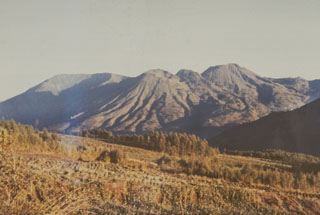Report on Dieng Volcanic Complex (Indonesia) — January 1993
Bulletin of the Global Volcanism Network, vol. 18, no. 1 (January 1993)
Managing Editor: Lindsay McClelland.
Dieng Volcanic Complex (Indonesia) Hot mud fountains and steam emissions; poisonous gas
Please cite this report as:
Global Volcanism Program, 1993. Report on Dieng Volcanic Complex (Indonesia) (McClelland, L., ed.). Bulletin of the Global Volcanism Network, 18:1. Smithsonian Institution. https://doi.org/10.5479/si.GVP.BGVN199301-263200
Dieng Volcanic Complex
Indonesia
7.2°S, 109.879°E; summit elev. 2565 m
All times are local (unless otherwise noted)
Hot mud began fountaining from a new vent (near the Pandawa Lima Temples) area at 0001 on 23 January. The fountaining was heard by residents of a nearby village (Bale Kambang). The hot mud, which emerged from a 5-m-diameter hole, had a temperature of 93°C and reached heights of 2-15 m. Hot mud and steam emissions were continuing on 8 February, with fountaining to 1 m height. The area within 25 m of the hole has been covered with mud. Gas measurements taken on 8 February detected 15 ppm HCN and 12 ppm H2S. Shallow volcanic earthquakes were recorded in January at rates of 3-20/day, but were decreasing prior to the 23 January activity. Seismicity has continued since then.
Geological Summary. The Dieng plateau in the highlands of central Java is renowned both for the variety of its volcanic scenery and as a sacred area housing Java's oldest Hindu temples, dating back to the 9th century CE. The Dieng Volcanic Complex consists of multiple stratovolcanoes and more than 20 small Pleistocene-to-Holocene craters and cones over a 6 x 14 km area. Prahu stratovolcano was truncated by a large Pleistocene caldera, which was subsequently filled by a series of cones, lava domes, and craters, many containing lakes. Lava flows cover much of the plateau, but observed activity has been restricted to minor phreatic eruptions. Gas emissions are a hazard at several craters and have caused fatalities. There are abundant thermal features and high heat flow across the area.
Information Contacts: W. Tjetjep, VSI.

